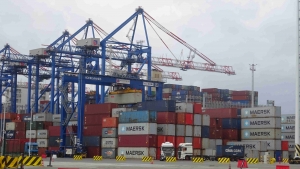Asian countries are leaders in trade, maritime transport and ship production

 By Marek Grzybowski
By Marek Grzybowski
In the second quarter of 2023, Asian economies were the countries with the largest number of maritime connections, as measured by the LSCI (Liner Shipping Connectivity Index), UNCTAD experts report in the latest “Review of Maritime Transport 2023”.
The PRC took first place, followed by the Republic of Korea, Singapore and Malaysia. These countries saw year-on-year LSCI growth of 3% to 5% and reached record highs in their indicators. This is another year of dynamic growth. Before the Covid 19 pandemic, the LSCI index of Chinese liner shipping in April 2018 was 187.780 compared to 2004, CEIC reported in the report.
LSCI UNCTAD
LSCI UNCTAD is based on quarterly data on the level of integration of countries and ports into global liner shipping networks. LSCI uses data from over 900 container ports around the world based on the use of six basic components related to the transport of containers by sea. UNCTAD data is based on MDSTransmodal statistics.
Asian countries continue to lead in terms of transhipment efficiency. According to the Container Port Performance Index (CPPI), developed jointly by the World Bank and S&P Global Market Intelligence, 18 of the world’s 25 largest ports are in Asia, including 11 in East Asia and four in West Asia.
China dominates maritime statistics
“No one is surprised that nine of the top ten on the list of 100 ports are Asian ports. Or that China has seven ports in the top ten, led by Shanghai, with transshipment of over 47 million TEU [in 2022 – MG” – writes George Lauriat, Editor in Chief, American Journal of Transportation in the report “AJOT’s top 100 container ports” .
He notes that “perhaps the only surprise in Shanghai’s numbers is that it did not become the first 50 million TEU port” and predicts that “50 million TEU will come.”
Almost all ports in China are developing dynamically and the country can boast of six ports with transshipment exceeding 20 million TEU in 2022. Only Hong Kong with 16.5 million TEU continues to fall in the rankings of the largest container ports. This is the result of competition from neighboring ports, or rather the activity of economic zones operating in the vicinity of Chinese ports.
Thanks to the economic activity of the regions around Shenzhen, container terminals have provided the port with 4 places with a container supply of over 30 million TEU. Guangzhou ranked 6th with 24.6 million TEUs. Meanwhile, Ningbo-Zhoushan, transshipping over 33 million TEUs (3rd position), has become a rival to Shanghai’s container terminals. However, it is a port handling 30 million TEUs with a large base of innovative industries.
Yangshan pillar of Shanghai?
The Port of Yangshan in China ranks first in the CPPI 2022 ranking, up from fourth place in 2021. This is the result of Yangshan investing in transhipment operations, developing automation and increasing the interoperability of its systems among border agencies and logistics operators.
The deep-water port of Yangshan is part of the port of Shanghai and is used by China for export expansion. For the immediate industrial zones, it is the main hub for international shipping. By 2021, the Port of Shanghai achieved annual throughput of 47 million TEU.
The port of Shanghai is on top
For 12 years in a row, the port of Shanghai was ranked first in the world. For years, almost half of the containers exported from the Shanghai area have been handled through the Yangshan port. Over 300 international liner shipping services arrive here. More than 80 of them start or end at Yangshan Port. The vast majority of connections are operated by ocean lines.
Modernization and investment activities undertaken in Yangshan have resulted in a whole range of economic effects built on the basis of the relationship between the business environment and the port management.
Tajung Pelepas Port
Tajung Pelepas Port in Malaysia rose 12 places to sixth in CPPI 2022. The ports of Ningbo in Guangzhou and Hong Kong in China are also among the top 10 ports covered by CPPI 2022, according to UNCTAD calculations.
Measuring port performance in minutes per container movement nationally, Hong Kong was the fastest in five call size categories. Japan and Vietnam recorded the fastest container handling speeds in three categories. Freight rates covering services from Asian ports to South America increased by 386% in 2022 compared to 2019. Rates from Asia to Africa increased by 160% and rates from Africa to Asia increased by 248%.
